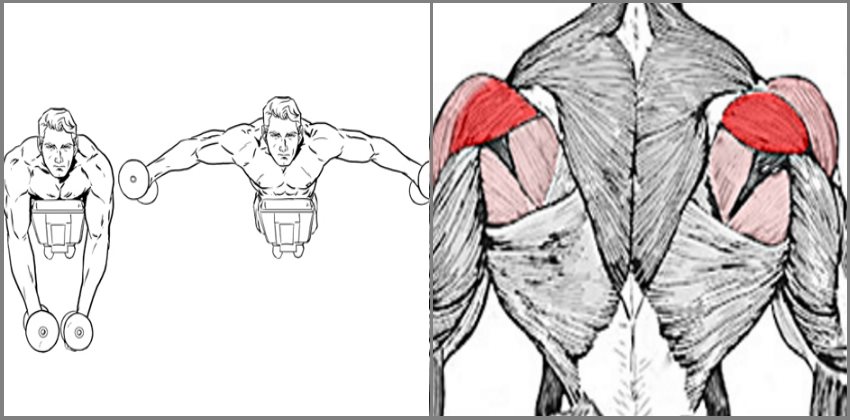One thing is certain : rear deltoids don’t get enough love and it’s not very surprising they’re a common weak point in many athlete’s physiques. That’s really unfortunate, since these small muscles play a very large role in achieving an impressive three-dimensional muscularity.
The two main reasons for neglecting the rear deltoids are pretty obvious: first, they’re best visible from the back so they get easily overshadowed by muscles that can be seen in the mirror, and second, they’re relatively weak compared to the other shoulder heads, so very few people decide to emphasize them in their regular routine.
However, there is another underlying problem when it comes to neglecting “unpopular” muscles: more often than not, bodybuilders don’t value the importance of having a structurally balanced and overall well-developed physique and they seem to ignore the fact that any weak link in the chain will ultimately become a limiting factor in some aspect of their performance.
So regardless of your goals, your rear delts deserve some attention, and luckily, there is an exercise that will help you develop them in the shortest time possible – it’s the reverse dumbbell fly.
Reverse dumbbell fly muscles worked
The reverse dumbbell fly is a bilateral exercise in the horizontal plane of movement which mainly targets the delts, the posterior muscles of the rotator cuff and the upper back muscles.
This means that besides efficiently hitting your rear delts, reverse dumbbell fly will strengthen your thoracic spinal muscles and improve your upper body posture and function, so incorporating them in your whole body program can help you significantly increase your back strength and mobility.
Reverse dumbbell fly other benefits
In case you need more reasons to add reverse dumbbell flyes in your back routine, we prepared a list of the most important benefits this great resistance exercises has to offer:
1. Improved posture
The dumbbell reverse fly helps strengthen the muscles responsible for pulling the shoulders backwards, thereby improving upper body posture and movement which is very important for both everyday activities and athletic performance.
2. Great muscle activation
One of the big reasons why this exercise is so effective is that it hits a big number of muscles with one simple movement. As we mentioned above, those include the delts, rotator cuff muscles and the scapula, all of which are usually neglected in a typical upper body routine.
And the more muscles a certain movement involves, the more bang for your buck you can get.
3. Injury prevention
Strengthening the rotator cuff is an imperative for anyone who would like to avoid serious shoulder injury.
The rotator cuff muscles – infraspinatus, supraspinatus, subscapularis and teres minor – are crucial for stabilizing the shoulder joint and enabling smooth movement of the shoulder muscles, yet they are one of the most commonly injured muscles.
Since the dumbbell fly involves a retraction of the scapula, a movement which co-operates with the rotator cuff muscles, it can significantly strengthen the latter, thereby keeping shoulder injury away.
How to perform the dumbbell reverse fly
As with any other exercise, proper form and technique are vital for success. Here’s how to perform dumbbell reverse flyes in a way that ensures optimal muscle activation, zero risk of injury and massive strength gains.

• Lie down on an inclined bench with the stomach and chest lying flat down, with a dumbbell in each hand with a neutral grip (palms facing inwards towards each other).
• Let the dumbbells hang straight down from your shoulders with your arms perpendicular to the angle of the bench. Your legs and torso should remain stationary all throughout the movement.
• Keeping a flat back, slightly bend your elbows, exhale and pull the weights away from each other laterally (to the sides) in an arc motion. Arm involvement should be minimal and the movement should be enabled by pulling through the elbows.
• Elevate the weights until your arms become parallel to the floor. At the top of the movement, squeeze your shoulder blades together and feel the contraction.
• As you inhale, slowly lower the weights back down to the original position but don’t allow them to bounce off each other.
• Repeat for the prescribed amount of repetitions.
That being said, here are some common mistakes to avoid when performing dumbbell reverse fly:
• Don’t allow your lower back to arch. This can lead to injury and reduce the effectiveness of the exercise.
• Don’t put too much of the tension on your biceps and focus on scapula retraction instead.
• After completing your sets, perform static stretches to enhance blood circulation and improve flexibility, as well as to reduce soreness and speed up recovery.
Here’s a sample shoulder training workout that will help you increase your shoulder’s conditioning and protect them from injury, which can substantially improve all of your major lifts.
Warm-up:
Perform upper-body dynamic stretches and rotator cuff mobility exercises.
The workout:
• Cable rope face-pulls: 3 drop-sets x 15 reps
• Smith machine shoulder press: 3 sets x 8-12 reps
• Single-arm standing shoulder press: 3 sets x 10 reps for each arm
• Dumbbell reverse flyes: 3 sets x 15 reps
• Cable pull-aparts: 3 sets x 12 reps
• Seated rope face-pulls: 3 sets x 15 reps
Post-workout:
Perform static stretches focused on the rotator cuff muscles.
Take-home message
Don’t forget that in bodybuilding, sometimes it’s not about how strong your strongest points are, but how you handle your weakest links. And since the rear delts are a common weak point for most, building a set of massive rear delts can definitely set you apart from the average bodybuilder!

